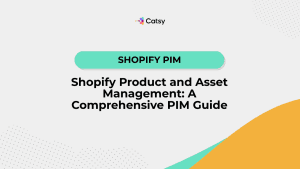Is PIM Software Worth It for Small Businesses?
Your Complete Navigation Guide
- Elizabeth Byrd
- August 27, 2025
- 6:51 am

Table of Contents
What You'll Learn:
- Why spreadsheets become a bottleneck as your business grows.
- How PIM boosts efficiency, accuracy, and scalability.
- The hidden costs of manual product management.
- How free PIM tools can help you test the benefits risk-free.
- Why small businesses see faster ROI than large enterprises.
Are you that small business owner? The one still managing product information in spreadsheets? Are you watching your competitors launch faster and expand to new channels?
You’re probably the one spending your weekends updating product descriptions across seven sales channels. Instead of golfing, you’re fighting version control issues and secretly worrying that one single data error will damage years-strong customer relationships.
If you’re questioning whether PIM software for small businesses is worth the investment, or are wondering how other companies are managing their operations, you’re facing a critical decision.
The truth is that the most successful small businesses didn’t just stumble into efficiency. They recognized that manual processes became growth constraints, and invested in systematic solutions before legacy systems became problematic.
Why PIM software could transform your small business operations
There’s a gap between small, efficiently scaling businesses and businesses that struggle with operational chaos. That gap is product information management.
Spreadsheet-Based Product Management Is Limiting Your Growth
1. Your spreadsheet-based product management is becoming a growth-limiting bottleneck
While you’re manually updating your product information across multiple spreadsheets, your successful competitor is launching products 50 percent faster without coordination nightmares.
According to Forrester research, teams that don’t have PIM tools risk a palpable competitive disadvantage with content that’s inconsistent, meets only the minimum market requirements, and fails to engage customers.
Teams that do use PIM win customers and expand their markets with product content that engages buyers and drives purchase decisions.
Your current approach may be working for you if you’ve got 50 to 100 products and one or two sales channels. But as you grow, it becomes increasingly difficult to maintain accuracy and consistency. Each new product, channel, or team member multiplies the complexity of your operations.
How centralized product information management transforms small business operations
Modern PIM software for small businesses eliminates scattered data chaos while providing the foundation for scalable growth.
- Single source of truth: All product information flows from one central location, eliminating version conflicts and ensuring consistency across every channel and team member
- Automated data distribution: Updates made once automatically propagate to all sales channels, reducing manual work by 60 to 80 percent while eliminating errors
- Quality control systems: Built-in validation prevents incomplete or incorrect information from reaching customers, protecting your brand reputation
- Team collaboration tools: Multiple team members can work simultaneously without conflicts, sharing responsibilities without creating chaos
- Scalable architecture: Systems grow with your business, handling unlimited products and channels without performance degradation
So you see, centralized management converts your scattered processes into a systematic competitive advantage. Rapid growth is now possible – without proportional increases in complexity.
The Hidden Costs of Manual Processes
2. The hidden costs of manual processes are destroying your competitive potential
The real cost of manual product information management is more than just time spent updating spreadsheets. It’s the growth you miss while your automated competitors capture market share. Companies managing 1,000 products across five channels could save over 1,666 hours annually with PIM, giving small businesses more time for strategic activities.
Studies show PIM can cut costs by at least 25 percent across 18 business functions. Hidden costs may include delayed launches, missed channel opportunities, customer service time fixing errors, and losing ground to faster, better-equipped competitors.
How systematic efficiency delivers measurable ROI
Small businesses typically see more dramatic returns from PIM implementation than larger ones. That’s because their operations are more completely and quickly converted.
- Time savings multiplication: Tasks requiring hours of manual work become automated processes, freeing team members for strategic activities
- Error reduction impact: Automated quality controls prevent costly mistakes that can damage customer relationships and increase return rates
- Channel expansion acceleration: New sales channels can be added in days, not weeks, enabling rapid testing and expansion opportunities
- Customer experience improvement: Consistent, accurate product information across all touchpoints builds trust and drives higher conversion rates
- Competitive response speed: Faster product updates and launches enable quicker responses to market trends and competitive threats
Most small businesses achieve positive ROI within 6 to 12 months through a combination of operational efficiency gains and revenue growth opportunities that are made possible by systematic product management.
Free PIM Software Options to Test the Waters
3. Free PIM software options can test the waters without breaking your budget
Many small businesses may find PIM to be cost prohibitive. But free and open-source options exist, delivering powerful features without major upfront costs. Tools like UnoPim provide centralized data management, multi-channel publishing, and DAM integration.
TreoPIM is another solid choice for smaller businesses, featuring a modern interface and high customization. These solutions let businesses test PIM benefits, proving value before committing to paid upgrades or commercial platforms.
How to leverage free solutions strategically
If you’re unsure about how a PIM will fit into your operations, free options provide wonderful insight. Test concepts while planning the foundation for future growth.
- Zero-cost experimentation: Test PIM workflows and benefits without financial risk, learning what works for your specific business needs
- Technical skill development: Teams gain experience with PIM concepts and best practices that will translate to any future system upgrades
- Proof of concept validation: Demonstrate ROI and operational improvements to justify future investments in more advanced solutions
- Foundation building: Establish data quality standards and systematic processes that support long-term growth
- Community support access: Active developer communities provide ongoing improvements, troubleshooting assistance, and feature development
Free PIM solutions work particularly well for businesses that have in-house tech expertise, simple catalogs, or just those who want to validate PIM benefits before making a more pricey commitment.
Faster ROI for Small Businesses
4. Small businesses achieve faster ROI than enterprises with focused implementations
Unlike large enterprises with complex legacy systems and bureaucratic hurdles, Small businesses that implement PIM solutions have an advantage: quick, immediate operational improvements. Their larger enterprise counterparts have complex legacy systems and bureaucratic hurdles.
Small businesses typically have fewer stakeholders, simpler organizational structures, and the greater agility needed to adapt to new systems. This creates advantages in implementation speed, user adoption, and the ability to optimize processes quickly based on real-world usage.
How focused implementation accelerates success
Small businesses can achieve transformational results by focusing on core functionality. Don’t attempt to implement every possible feature of your PIM at once!
- Rapid deployment: Simple organizational structures enable faster decision-making and implementation timelines of 2 to 4 weeks versus months for enterprises
- Immediate impact: Smaller product catalogs and teams mean improvements are felt immediately across the entire organization
- Agile optimization: Quick iteration and improvement based on actual usage patterns and business needs
- Team alignment: Easier communication and training with smaller teams leads to faster adoption and more effective utilization
- Clear ROI measurement: Direct correlation between PIM improvements and business results makes ROI calculation straightforward
Small businesses often report seeing operational improvements within the first month of implementation, with full ROI achievement typically occurring within 6 to 12 months.
Future-Proofing Your Business with Systematic Data Management
5. Future-proofing your business requires systematic product data management
The digital commerce landscape is ever-evolving. Increasing customer expectations, expanding channel opportunities, and growing complexity mark this evolution. This makes manual product management increasingly unsustainable.
The integration of AI, voice commerce, AR experiences, and even sustainability reporting all depend upon well-organized product data. Your manual systems can not provide this at scale.
How PIM investment prepares for future opportunities
Systematic product information management creates a solid foundation for adopting emerging technologies and capturing marketing opportunities as they arise.
- AI integration readiness: Well-structured product data allows for automatic content generation, SEO optimization, and personalization
- Channel expansion flexibility: New sales channels, from voice shopping to social commerce, can be added quickly without major data restructuring
- Compliance preparation: Increasing regulations around product transparency and sustainability require comprehensive data tracking … PIM systems provide this
- International expansion capability: Multi-language and multi-currency features enable global expansion without operational complexity multiplication
- Technology adaptation: API-first architectures support integration with emerging tools and platforms as they become relevant
Put simply, a small business that establishes proper data management practices now will later be able to navigate requirements and opportunities more smoothly.
Key Takeaways
- PIM centralizes product data, improving speed and accuracy.
- Manual processes drain time, cause errors, and hurt growth.
- Free PIM options let you experiment without major costs.
- Small businesses can implement PIM faster and see quick ROI.
- PIM prepares you for emerging tech and future market demands.
FAQs:
Why do Excel spreadsheets become problematic for growing businesses?
Excel systems that work great with a hundred SKUs become impossible to manage with thousands. Every new channel multiplies coordination complexity, team members add version control risks, and product launches take longer due to manual coordination.
What percentage of Excel to PIM migrations fail and why?
Data preparation failures doom 40 percent of migrations due to inadequate cleaning, standardization, and organization of Excel data. This creates quality issues that require expensive rework or complete project restarts.
How long should businesses plan for a complete Excel to PIM migration?
Plan for 3 to 6 months for complete migration with 35 to 40 percent of project time invested in data preparation. Allow for progressive implementation phases and comprehensive testing protocols.
What are the most common pitfalls that derail migration projects?
Common pitfalls include rushing your data prep, insufficient testing, unrealistic timelines, integration complications, user adoption resistance, and inadequate change management planning.
How much efficiency improvement can businesses expect after successful migration?
Businesses can achieve an 80 percent reduction in manual data processing time, 99.5 percent accuracy improvements, and revenue growth from multi-channel capabilities through systematic post-migration optimization.





